PDF chapter test TRY NOW
Introduction
The skeletal system comprises bones, cartilages and joints. The bones of the skeletal system provide a framework of the body.
The movement of the animals or the human body occurs in a variety of ways. Certain parts of the body can be moved in various directions, and some features can be moved only in one direction.
All these movements and their variations are because of the bones that are attached by joints. The bones, along with the muscles, help in movements such as walking, running, chewing and so on.
The bones found in the body of humans form a framework known as the skeleton that gives shape to the body.
Human skeletal system
The skeleton is a structural framework of bones which are linked together by joints. In humans, there are around \(305\) ones at birth. With the increase of age, some of the bones fuse, resulting in only \(206\) bones, a few cartilages and a few ligaments and tendonsthat make up the skeleton.
The ligaments are structures that help in connecting the bones to the muscles. The human skeleton is divided into the:
- Axial skeleton
- Appendicular skeleton
Axial skeleton
The axial skeleton forms the upright axis of the body that includes,
- Skull
- Vertebral column
- Rib cage

Axial skeleton system
1. Skull
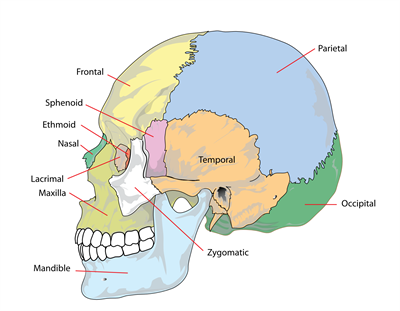
Human skull - Side View
The skull is a structure made up of many bones known as the cranial bones and facial bones. These bones are joined together to enclose and protect the brain and the structures of the face.
The hyoid bone found at the base of the buccal cavity and the auditory ossicles such as Malleus, Incus and Stapes is also included in the skull. The lower jaw bone is the largest and the strongest bone in the human face.
Important!
The stapes is the smallest bones in the body. Approximately it is \(2.8\) mm long.
2. Vertebral column
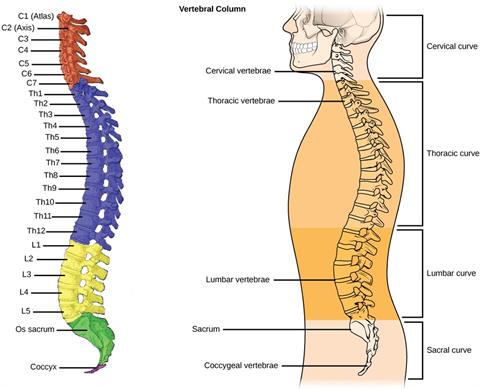
Vertebral column
It is also known as the backbone. It extends from the base of the skull and consists of many small bones called vertebrae that are \(33\) in number and are serially arranged.
The vertebral column protects the spinal cord. A person can bend over only due to the presence of this bone.
3. Rib cage
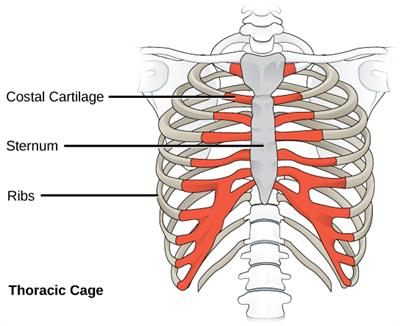
Rib cage
There are \(12\) pairs of curved and flat rib bones on each side of the chest joined to the central chest bone and the backbone.
They enclose the important, delicate organs such as the lungs and the heart.
Appendicular skeleton
The appendicular skeleton includes the pelvic and pectoral girdles and the bones of the limbs of the arm and leg.
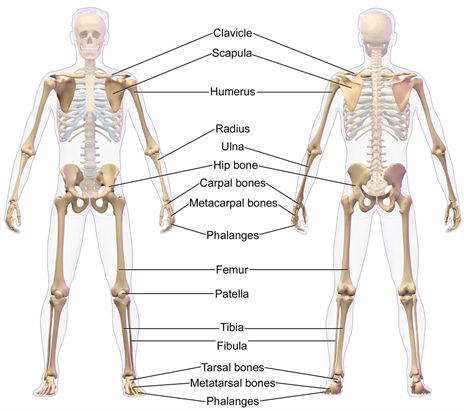
Appendicular skeleton system
1. Limbs
Humans have two pairs of limbs. They are the upper limbs, also known as the fore limbs, and the lower limbs, also known as the hind limbs.
The fore limbs are used for various functions such as holding, writing, etc., and the hind limbs are used for walking, sitting etc.,
Some of the bones of the arms are the shoulder bones and the carpels.
The two prominent bones on the back are known as the shoulder bones and the bones of the wrist, and the palm is known as the carpels. One can fold their fingers only due to these carpels.
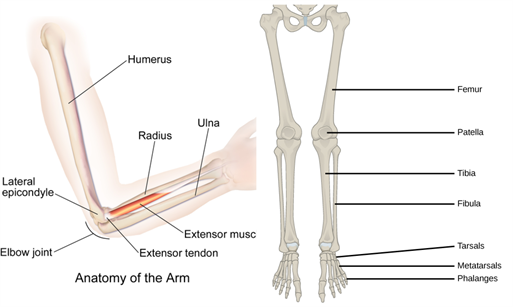
Upper and Lower limbs
Important!
The thigh bone, called the femur, is the longest bone in the body.
Girdle
The fore limbs and the hind limbs are attached to the axial skeleton by the pelvic and pectoral girdles.
1. Pelvic bone
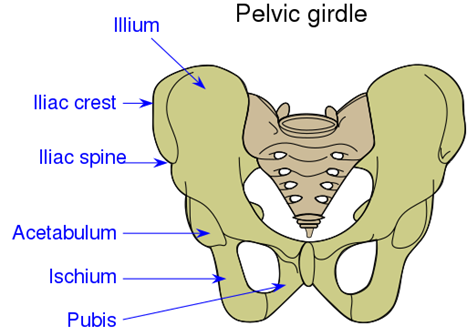
Pelvic girdle
It's a structure that protects the parts of the body below the stomach. It supports sitting correctly.
2. Pectoral girdle

Pectoral girdle - Front and back view
The appendicular skeleton's bones link to the arm on either side, forming the shoulder girdle, also known as the pectoral girdle.
Other structures of skeleton system
Cartilage and muscle are two additional structures that are part of the skeletal system.
1. The soft structure found between the joints of the skeleton and the upper portion of the ear lobe is known as a Cartilage.
2. The soft contractile tissueattached to the bones is known as Muscle.
2. The soft contractile tissueattached to the bones is known as Muscle.
What are joints?
Have you ever wondered how we are able to bend and rotate our body parts? It is because of the joints present in our body.
The connection between two bones in the skeletal system is a joint.
Bones are rigid structures that cannot be bent or rotated. But still, we can do so with the help of joints. Hence, joints play a prominent role in the movement and locomotion of animals such as humans.
Not all the parts of the body can be moved easily. Only the places where two bones join together can be moved easily. These places are known as joints.
Reference:
https://commons.wikimedia.org/wiki/File:Axial_skeleton_diagram_ro.svg
https://commons.wikimedia.org/wiki/File:Figure_38_01_07.jpg
https://commons.wikimedia.org/wiki/File:Figure_38_01_08.jpg
https://commons.wikimedia.org/wiki/File:Appendicular_Skeleton.png
https://upload.wikimedia.org/wikipedia/commons/3/32/Figure_38_01_13.jpg
https://commons.wikimedia.org/wiki/File:Arm_Bones.png
https://commons.wikimedia.org/wiki/File:Figure_38_01_10.jpg
https://commons.wikimedia.org/wiki/File:Pelvic_girdle_illustration.svg
